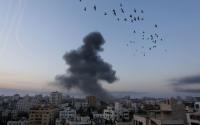1 May 2006Jonathan B. Tucker and Paul F. Walker
This weekend marked the ninth anniversary of the international Chemical Weapons Convention, which bans the development, production, and use of deadly chemical agents and requires the destruction of existing stockpiles.
One year remains until the deadline for completing the destruction of all declared chemical weapons stocks, more than 71,000 metric tons globally. Yet only about 13,000 tons (18 percent) have been destroyed, requiring the treaty timetable to be extended. Of the six countries that have declared chemical stockpiles under the convention, only one -- Albania -- has any chance of eliminating them on time. Despite this setback, we must not abandon the goal of ridding the world of these weapons.
The United States and Russia, which possess more than 95 percent of the Cold War stockpiles of chemical arms, have both requested a five-year extension of the deadline until 2012, as permitted under the treaty. By mid-April, the United States had destroyed about 39 percent of its declared inventory of 28,575 metric tons stored at eight Army depots around the country. But Defense Secretary Donald Rumsfeld, in an April 10 letter to congressional leaders, admitted that the United States will destroy only about 66 percent of the stockpile by April 2012.
Russia is further behind, having destroyed less than 3 percent of its 40,000 metric tons by the end of March. Both the United States and Russia will likely take another decade to eliminate their aging and dangerous chemical arsenals.
Four other countries -- Albania, Libya, South Korea, and India -- have declared much smaller chemical weapons stockpiles and pledged to destroy them, while Japan is faced with eliminating the vast buried stockpile that it abandoned in China during World War II.
Albania possesses 16 tons of a mixture of two blister agents in barrels, discovered in 2002 by Albanian officials searching for weapons caches. Because some of these containers bear Chinese labels, it is suspected that Albania's former communist regime imported them during the 1980s from the People's Republic of China. The United States is helping Albania to destroy its stockpile, with additional assistance from Greece, Italy, Switzerland, and the European Union. Destruction is slated to begin in July and should be completed by April 2007, the convention's deadline, should no unanticipated delays occur.
Libya has declared 23.62 metric tons of mustard agent and more than 1,300 metric tons of chemical ingredients for making nerve agents, stored at a remote site in the Libyan desert. The cost of elimination is estimated at about $100 million, which Washington has agreed to fund with congressional approval. The timeline for destruction is uncertain because of several political obstacles, not least the fact that Libya remains on the State Department's list of state sponsors of terrorism. To cover the worst case, Tripoli will probably request a five-year extension until 2012.
South Korea has declared a single chemical weapons production facility and a stockpile of 156,000 sarin artillery shells of the ''binary" type, in which the lethal agent is produced only after the shells are fired. By the end of March, Seoul had incinerated 67 percent of the binary agents; it aims to eliminate the rest by December 2008, also requiring an extension of the deadline.
India has a declared stockpile of 1,044 metric tons of sulfur mustard. Less than 2 percent of the agent was filled into artillery shells and the remainder stored in bulk containers. As of March, India had destroyed 53 percent of its stockpile, including all of the filled munitions, but it will probably need an extension until 2009 to complete the process.
Japan, although not a current possessor of chemical weapons, abandoned large stocks of chemical munitions in northeastern China during World War II. China contends that some 2 million Japanese chemical shells, containing a total of about 100 metric tons of agent, remain to be recovered, while Japan estimates the total number as closer to 700,000. Although the convention is somewhat vague about the deadline for destroying old and abandoned chemical weapons, China is urging Japan to request an extension.
A number of other states that have not yet joined the convention are believed to possess chemical weapons, including Egypt, Israel, Syria, and North Korea. Egypt, a close US ally, has so far refused to sign the convention but has proposed a Middle East free of all weapons of mass destruction. Israel has signed the convention but declined to ratify the treaty until its hostile neighbors, Syria and Iran, give up their own alleged chemical warfare capabilities. (Although Iran is a party to the convention, the US government claims that it retains illicit chemical weapons production facilities and possibly an active stockpile.) Another holdout, North Korea, has an estimated 2,500-5,000 tons of blister and nerve agents, much of which is weaponized in artillery shells and rockets within firing range of Seoul.
The latest delays by the United States, Russia, and other countries in destroying their stockpiles are troubling, particularly given the risk that poorly secured weapons could fall into the hands of terrorists. It is essential for governments and nongovernmental organizations to continue pressuring all states that possess chemical arms to join the Chemical Weapons Convention and destroy their stocks as quickly and safely as possible. Only by keeping our eyes on the prize will it be possible to eliminate this entire class of weapons of mass destruction.
Jonathan B. Tucker is a senior fellow at the Center for Nonproliferation Studies and author of ''War of Nerves: Chemical Warfare from World War I to Al Qaeda." Paul F. Walker is legacy program director at Global Green USA.






